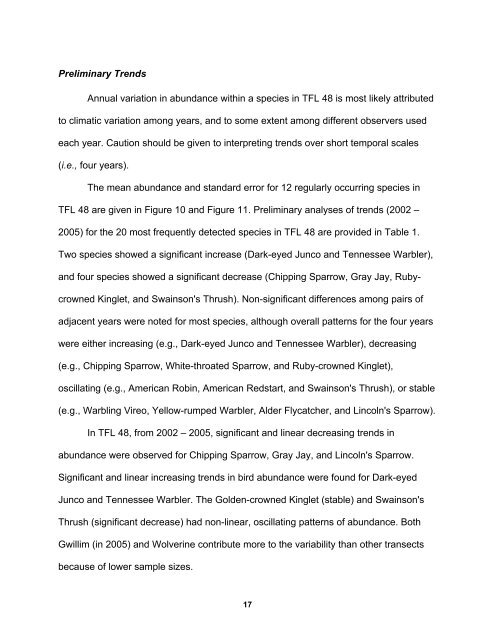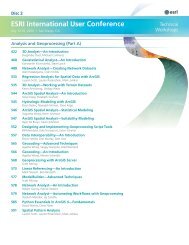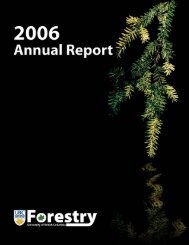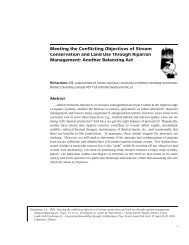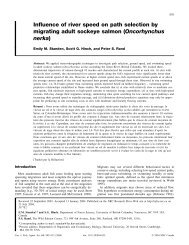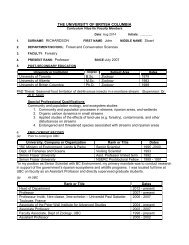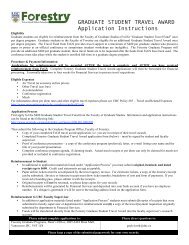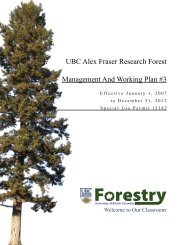A Four-year Summary of Breeding Bird Surveys in TFL 48 ... - BIOD
A Four-year Summary of Breeding Bird Surveys in TFL 48 ... - BIOD
A Four-year Summary of Breeding Bird Surveys in TFL 48 ... - BIOD
Create successful ePaper yourself
Turn your PDF publications into a flip-book with our unique Google optimized e-Paper software.
Prelim<strong>in</strong>ary TrendsAnnual variation <strong>in</strong> abundance with<strong>in</strong> a species <strong>in</strong> <strong>TFL</strong> <strong>48</strong> is most likely attributedto climatic variation among <strong>year</strong>s, and to some extent among different observers usedeach <strong>year</strong>. Caution should be given to <strong>in</strong>terpret<strong>in</strong>g trends over short temporal scales(i.e., four <strong>year</strong>s).The mean abundance and standard error for 12 regularly occurr<strong>in</strong>g species <strong>in</strong><strong>TFL</strong> <strong>48</strong> are given <strong>in</strong> Figure 10 and Figure 11. Prelim<strong>in</strong>ary analyses <strong>of</strong> trends (2002 –2005) for the 20 most frequently detected species <strong>in</strong> <strong>TFL</strong> <strong>48</strong> are provided <strong>in</strong> Table 1.Two species showed a significant <strong>in</strong>crease (Dark-eyed Junco and Tennessee Warbler),and four species showed a significant decrease (Chipp<strong>in</strong>g Sparrow, Gray Jay, RubycrownedK<strong>in</strong>glet, and Swa<strong>in</strong>son's Thrush). Non-significant differences among pairs <strong>of</strong>adjacent <strong>year</strong>s were noted for most species, although overall patterns for the four <strong>year</strong>swere either <strong>in</strong>creas<strong>in</strong>g (e.g., Dark-eyed Junco and Tennessee Warbler), decreas<strong>in</strong>g(e.g., Chipp<strong>in</strong>g Sparrow, White-throated Sparrow, and Ruby-crowned K<strong>in</strong>glet),oscillat<strong>in</strong>g (e.g., American Rob<strong>in</strong>, American Redstart, and Swa<strong>in</strong>son's Thrush), or stable(e.g., Warbl<strong>in</strong>g Vireo, Yellow-rumped Warbler, Alder Flycatcher, and L<strong>in</strong>coln's Sparrow).In <strong>TFL</strong> <strong>48</strong>, from 2002 – 2005, significant and l<strong>in</strong>ear decreas<strong>in</strong>g trends <strong>in</strong>abundance were observed for Chipp<strong>in</strong>g Sparrow, Gray Jay, and L<strong>in</strong>coln's Sparrow.Significant and l<strong>in</strong>ear <strong>in</strong>creas<strong>in</strong>g trends <strong>in</strong> bird abundance were found for Dark-eyedJunco and Tennessee Warbler. The Golden-crowned K<strong>in</strong>glet (stable) and Swa<strong>in</strong>son'sThrush (significant decrease) had non-l<strong>in</strong>ear, oscillat<strong>in</strong>g patterns <strong>of</strong> abundance. BothGwillim (<strong>in</strong> 2005) and Wolver<strong>in</strong>e contribute more to the variability than other transectsbecause <strong>of</strong> lower sample sizes.17


